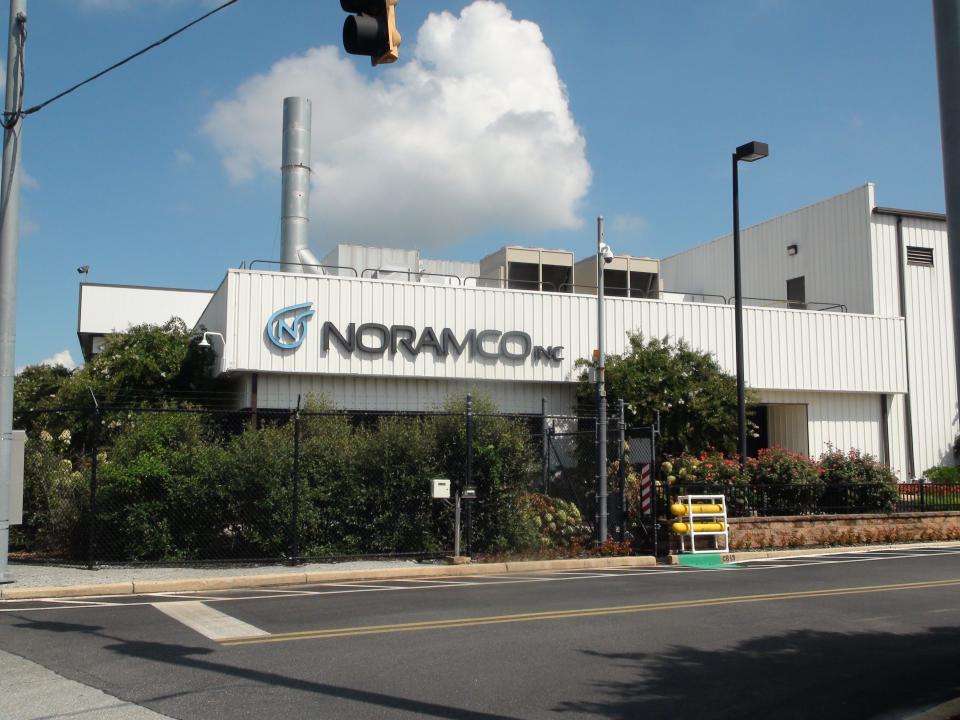Wilmington residents upset by little notice of global drug maker's expansion plans
A Wilmington-based global producer of controlled substances for the pharmaceutical industry plans to expand production, a decision some residents say both concerns them and has caught them off-guard.
Headquartered in Wilmington's Eastside, Noramco is a leading manufacturer of cannabinoids, narcotics, opioids and other substances used to treat conditions such as behavior disorders, pain and addiction. Davon Marque Hall, 36, is a resident of the Eastside. He became alarmed when he found out Noramco submitted a building permit to install a new vacuum pump and expand its production for two more products.
Noramco's permit reveals that the manufacturing process of the two new products will release toxic compounds and hazardous pollution into the atmosphere. The company stated the new vacuum pump will reduce these emissions to levels that comply with regulations.
As published by the Occupational Safety and Health Administration, certain chemicals used by the company in its drug production have the potential to enter the respiratory system through breathing or can be absorbed through the skin. Representatives for Noramco did not respond to a Delaware Online/The News Journal request for comment by the stated publication deadline.
In a post on its website, the Department of Natural Resources and Environmental Control advised that a public hearing on the permit application would be scheduled only if a request was received within 15 days of the Aug. 20 notice. Hall requested a public hearing on Sept. 2 — 48 hours before the Sept. 4 deadline.
Aggrieved by the process, Hall said that as a matter of democratic function, the state agency should do more to engage the public on matters of health and safety. "If they want to bring it here [and] if the community believes that it's good, I believe that democracy should win," Hall said. "We should be able to vote on what happens, and everyone should be involved in the process."
Ways DNREC says public can stay informed, ask questions
DNREC Division of Air Quality Director Angela Marconi advised that while DNREC may invite requests for a public hearing, the formal legal proceeding may not be the most practical platform for addressing concerns.
Instead of a public hearing, Marconi recommended that residents utilize the contact information provided in the notice if they have any questions or seek further information about a permit. Marconi explained that DNREC typically only fulfills the requirements set by the statute, which involve holding a public hearing and gathering public comments.
Marconi clarified that the state agency encourages resident input and shares notices regarding applications, permits, decisions and plans on its website and in newspapers. Additionally, individuals can opt to receive email notifications.
DID DNREC VIOLATE CIVIL RIGHTS?: EPA investigating whether Delaware violated civil rights in approval of Seaford plant
"I'm interested in hearing what the questions and concerns are, and people can reach out to us directly," Marconi said. But she added, "The public has to show up and want to communicate with us."
She said in her experience when hearings were held there was no community attendance.
Under Title VI of the 1964 Civil Rights Act, DNREC has access to funding from the U.S. Environmental Protection Agency to build capacity for community engagement. This includes technical assistance and environmental justice grants to develop community-based advocacy groups. It is unclear whether DNREC has requested this assistance.
Eastside Wilmington — environmentally burdened with pollution
Eastside, like much of the majority Black communities in Wilmington and the Route 9 corridor, is environmentally polluted. It is listed in the 95-100 percentile of the EPA environmental justice screening and mapping tool for toxic air hazards.
DNREC's environmental justice map fails to include toxic release data.
Earlier this year, DNREC hired its first environmental justice coordinator, Katera Moore. According to its website, the environmental justice coordinator would work with communities that "historically have experienced disproportionately adverse human health and environmental impacts to their minority and low-income populations."
Hall, the Eastside resident, said he had never heard of her.
When asked why DNREC's environmental justice coordinator wasn't involved in engaging the Eastside neighborhood, Marconi said, "We check in with Katera regularly when we have concerns and questions, [and] bounce ideas off of her."

Marconi added that in addition to their existing efforts to communicate with residents, because Noramco is located near an "equity focus area," DNREC officials reached out to the Southbridge Civic Association. The Southbridge Civic Association represents the Southbridge neighborhood located on the other side of the Christina River. The civic organization representing the Eastside neighborhood is the Eastside Civic Association.
Contact information for Wilmington's civic associations is available on the city's website or by calling the Office of Constituent Services. There was no mention of an attempt to reach the Eastside Civic Association or any of the environmental groups representing communities in Wilmington and New Castle County's most polluted areas.
Risks to public health and safety overlooked in the past
Eastside resident Don Farrell said he is worried about Noramco's plans to expand.
The 67-year-old was born and raised in the neighborhood. Farrell said he became interested in the drugmaker about 30 years ago. "We were in the midst of a serious drug epidemic, over here on the Eastside," Farrell said. "So I started asking questions. I started doing my research."
Farrell said he discovered that the company's manufacturing process uses the solvent methylene chloride to process crushed dried poppies or poppy straw.

"Having worked at the DuPont Experimental Station for almost 16 years, I'm kind of familiar with the industry. And I know that when they say the solvent [methylene chloride] stays within a fenceline, that's just not true."
In 2017, the EPA proposed a rule that would prohibit the manufacture (including import), processing, and distribution of methylene chloride in commerce.
Farrell believes that Eastside residents are inhaling the toxic air emitted from the drug manufacturing processes taking place near their homes and have become "desensitized to it." Farrell said that despite what is officially documented, on any ordinary day, if a pedestrian who lives outside of the area walks by Noramco, they would feel the effects immediately because of the solvents in the atmosphere.
POLLUTERS WIN IN COURT: New Castle residents lose court battle to force Croda to pay for health monitoring
Also concerning Farrell is the potential of another Croda incident occurring if this new production line is implemented. In November 2018, equipment failure led to a leakage of nearly 3,000 pounds of flammable ethylene oxide gas from Croda International Plc. at Atlas Point. This incident resulted in the temporary closure of the Delaware Memorial Bridge and a warning to nearby residents to take shelter.
In March 2020, a federal watchdog urged the EPA to "promptly" hold public meetings in New Castle and 16 other locations across the country to inform residents living near ethylene oxide facilities that the chemical is 30 times more cancerous for adults than previously thought.
The new health risks were discovered in 2017, but the government failed to relay the message to the people most at risk, according to the watchdog report, published by the EPA's independent Office of Inspector General. Farrell said given what Noramco produces, he wonders if there are any plans to protect residents from another catastrophic event.
The public hearing that Hall requested is expected to be scheduled by December. Farrell said he also plans to attend.
Contact reporter Anitra Johnson at ajohnson@delawareonline.com. Join her on the Facebook group Delaware Voices Uplifted. Support her work and become a subscriber.
This article originally appeared on Delaware News Journal: Residents seek public hearing for environmental justice concerns

